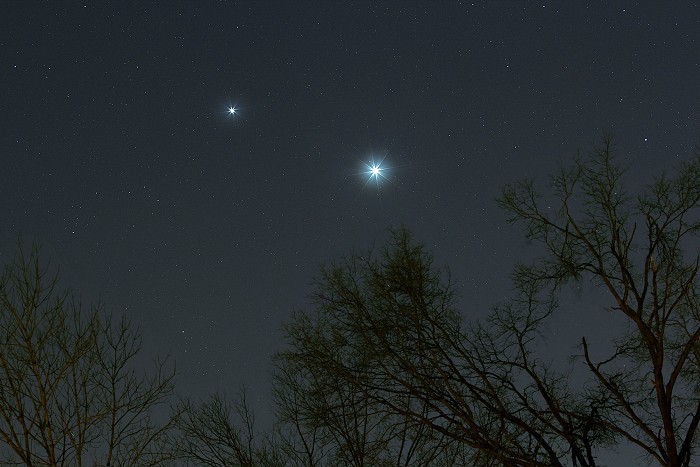| Online: | |
| Visits: | |
| Stories: |
Skywatch: Venus and Jupiter continue to accentuate the night heavens
Saturday, February 28, 2015 18:35
% of readers think this story is Fact. Add your two cents.
Discussions concerning all matters of humanity’s ascension into a higher dimensional existence culminating in 2012
 |
| Venus (right) & Jupiter |
Excerpt from washingtonpost.com
By Blaine Friedlander Jr.
In winter’s waning weeks, Venus and Jupiter continue to accentuate the night heavens, we change our clocks forward and we grab spring with no intention of letting go.
Check the west-southwestern heavens at dusk to spy the vivacious Venus and the dim Mars. In late February, the two planets met for a sweet cosmic waltz, but in March, they appear to separate. Venus approaches negative fourth magnitude (very bright) while Mars makes do at magnitude 1.3 (dim, hard to find in urban light pollution). With a clear sky, Mars looks like a red pinpoint.
A young, waxing crescent moon visits Mars on the evening of March 21, and on the next evening the crescent flirts with Venus.
Robust Jupiter ascends the evening’s eastern sky. Find this gas giant at a -2.5 magnitude, very bright, in the constellation Cancer. The lion in the constellation Leo appears to stare at the planet. By the Ides of March, find it south around 10:30 p.m.
The waxing gibbous moon drops by the dazzling Jupiter on March 2, days before the moon itself becomes full on March 5.
Catch the ringed Saturn rising after midnight in the east-southeast now, hanging out near a gang of constellations, Scorpius, Ophiuchus and Libra. It’s a zero magnitude object, bright enough that it can be seen under urban skies. The waning moon loiters near Saturn before dawn on March 12. On that morning, the reddish star below them is Antares.
We adjust our clocks to Daylight Saving Time at 2 a.m. March 8. Spring forward, moving the clock ahead one hour.
Winter is almost over. Spring is weeks away. The vernal equinox brings spring’s official arrival on March 20 at 6:45 p.m.
Also on March 20 — the day a new moon — the North Atlantic and the Arctic waters get a short total eclipse. We won’t see it here, but Slooh.com will carry it live. Totality will start seconds after 5:44 a.m. and end at 5:47 a.m., according to Geoff Chester of the U.S. Naval Observatory.
http://ascensionearth2012.blogspot.com
Source: http://www.ascensionearth2012.org/2015/02/skywatch-venus-and-jupiter-continue-to.html




